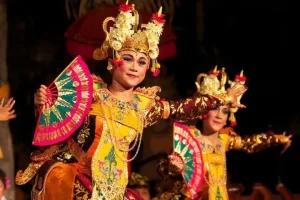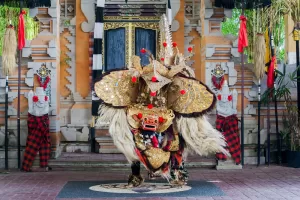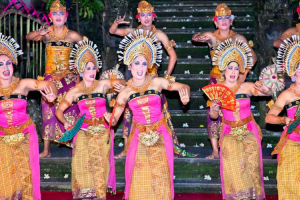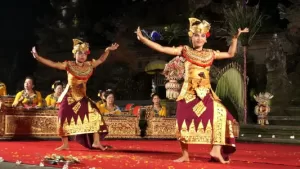For a long time, Bali’s Culture has attracted the world’s attention due to its beauty and uniqueness. Located in the heart of the Indonesian archipelago, Bali has become a highly sought-after tourist destination for travelers from all over the world. However, the beauty of its nature and the hospitality of its people represent only a small part of Bali’s charm. What truly makes Bali exceptional is the richness of its culture, so diverse and profound.
As one of Indonesia’s provinces, Bali possesses a rich and varied cultural heritage. From enchanting dance and music arts to traditional ceremonies imbued with meaning, Balinese culture reflects the spiritual and social life of its population. Every aspect of this island’s Bali’s Culture radiates local elegance and wisdom that have been preserved over the centuries. In this article, we will explore six fascinating traditional Balinese dances, delving into the history and significance of each graceful and magnificent movement.
6 Traditional Balinese Dances
1.Tari Legong

Source: Sering Jalan
Tari Legong is one of the most famous and beautiful traditional Balinese dances. This dance is usually performed by a group of young dancers wearing magnificent traditional Balinese costumes. Their costumes consist of the characteristic Balinese fabric called “kebaya,” adorned with intricate patterns, as well as a crown-shaped headdress called “sanggul,” decorated with fresh flowers. Tari Legong is filled with gentle and graceful movements that tell classic Balinese stories.
One of the main features of Tari Legong is the expressive movement of the eyes, blinking rapidly. This creates the impression that the Legong dancers are celestial beings or enchanting nymphs. The music accompanying this dance is also very distinctive, using traditional Balinese instruments such as gamelan, gong, and gender. The combination of the dancers’ grace, magnificent costumes, and enchanting music makes Tari Legong one of the main attractions of Balinese culture, often performed at various artistic events and traditional ceremonies on the island.
Beyond its beauty, Tari Legong also holds deep meaning in Balinese culture. This dance often represents mythological narratives or traditional stories with moral and spiritual messages. Thus, Tari Legong is not just an artistic spectacle but also carries profound cultural and spiritual values for Balinese society. Legong illustrates romantic tales or myths often associated with Hindu goddesses like Dewi Sri.
2.Tari Barong

Source: Pegipegi
Tari Barong is one of Bali’s most iconic dances and is often performed during traditional ceremonies and festivals. This dance is usually enacted during rituals, weddings, or other special events. Tari Barong depicts the battle between Barong, a mythical creature in the form of a lion or wild boar, and Rangda, a demonic figure. This dance represents the struggle between good and evil and is considered a symbol of protection against malevolent forces.
During the performance of Tari Barong, the dancers wearing the Barong costume dance with powerful and agile movements, while those in Rangda’s costume execute frightening and terrifying movements. The gamelan music played during the performance creates a deep and dramatic atmosphere for the battle between Barong and Rangda. Tari Barong also involves other characters, such as dancers in monkey costumes, adding a touch of comedy to the performance.
Tari Barong is not just an artistic spectacle; it also holds spiritual significance in Bali’s Culture. The battle between Barong and Rangda is seen as a symbol of humanity’s struggle against evil forces and negative influences in daily life. This dance is also often perceived as a means of maintaining balance between nature and human life. With its dramatic movements and powerful narrative, Tari Barong Bali remains one of the island’s most precious and fascinating cultural heritages.
3.Tari Kecak

source: pegipegi.com
Tari Kecak is one of the most unique and captivating traditional Balinese dances. This dance is famous for the repeated chanting of “cak-cak-cak” by male dancers sitting in a circle. Tari Kecak is often performed as part of the famous Ramayana epic, focusing on the story of Rama and Sita. Performances of Tari Kecak typically take place outdoors, such as on the beach or in temples, with male dancers wearing traditional costumes and head ornaments.
One of the distinctive features of Tari Kecak is the dance of the character Hanuman, a monkey character in the Ramayana epic. Hanuman plays a crucial role in helping Rama rescue Sita from Ravana, adding a comedic and dynamic dimension to the performance. The gamelan music accompanying this dance creates a dramatic and deep atmosphere, while the hand and body movements of the dancers beautifully convey the story.
Tari Kecak is not just a dance; it reflects Bali’s rich culture and spirituality. In the Ramayana epic, this dance symbolizes the battle between good and evil, while the powerful chant “cak-cak-cak” brings a mystical touch and a hypnotic ambiance to the performance. Tari Kecak is one of Bali’s most famous artistic heritages and continues to attract tourists from around the world.
4.Tari Pendet

Source: Indonesia Kaya
Bali’s Tari Pendet is one of the most iconic and beautiful traditional dances on the island of Bali, Indonesia. This dance is known for its grace and is often performed at various religious ceremonies, traditional rituals, and artistic and cultural events in Bali. Pendet is a group dance typically performed by a group of young female dancers wearing traditional Balinese costumes.
One of the distinctive features of Tari Pendet is the graceful hand movements. Dancers hold flowers or offerings in small baskets placed on their heads. Coordinated hand movements and joyful expressions on their faces are the highlights of this dance. Tari Pendet represents a form of offering to the gods and goddesses of the Balinese Hindu religious tradition, which is the majority religion on the island. This dance expresses gratitude and joy for the blessings received from the deities.
Costumes worn in Tari Pendet are typically very colorful and ornate. Dancers wear sarongs and kebayas, as well as accessories like scarves, floral head ornaments, and traditional Balinese jewelry. This dance is often accompanied by gamelan music, which sets the rhythm for the dancers’ movements in a distinctive way. Tari Pendet is a captivating manifestation of Balinese art and cultural beauty, and it remains one of the top attractions for tourists visiting the island.
5.Tari Janger

Source: Gramedia
Tari Janger is one of the traditional Balinese dances that represents the social and cultural life of society on the island. This dance is famous for the performance of a group of dancers who sing joyfully in harmony. Tari Janger is often performed at various festive and religious ceremonies in Bali, and it also serves as an attraction for tourists eager to experience the beauty of traditional Balinese art.
One of the features of Tari Janger is the pairing of male and female dancers. Female dancers typically wear magnificent costumes, often adorned with flowers on their heads and scarves, while male dancers wear sarongs and traditional Balinese costumes. Movements in Tari Janger are lively and depict everyday life situations such as planting, fishing, or other activities.
Tari Janger is also known for its accompanying music, the gamelan. The gamelan music accompanying this dance creates a joyful and cheerful atmosphere. Dancers and gamelan musicians work in harmony to create a captivating performance. Tari Janger is one of the expressions of Bali’s rich artistic and cultural heritage, highly appreciated and preserved to this day.
6.Tari Panji Semirang

source:dictio.id
Tari Panji Semirang is one of the traditional dances originating from Bali, Indonesia. This dance is part of Bali’s rich and varied cultural repertoire. Tari Panji Semirang is typically performed by a group of female dancers wearing colorful and vibrant costumes. A distinctive feature of this dance is the use of a fan as an essential prop in the performance.
The story told in Tari Panji Semirang revolves around a prince named Panji in search of his beloved, Candra Kirana. This story is often adapted into various forms of traditional Balinese arts, including dance. The dancers portraying the characters of Panji Semirang perform gentle and elegant movements, creating a romantic atmosphere in the performance. The costumes worn are also highly attractive, with vivid colors that reflect Bali’s natural beauty.
Tari Panji Semirang is not just a performance; it is an integral part of Bali’s cultural heritage. It is often an attraction for tourists eager to experience the beauty of traditional Balinese dance and learn more about the classical narratives integrated into this art. With its graceful movements and magnificent costumes, Tari Panji Semirang is one of the most captivating and enchanting dances in Bali’s rich artistic culture.
Conclusion
To appreciate and understand Bali’s Culture, exploring these traditional dances is a valuable first step. Each of these dances has its own meaning and uniqueness, playing an important role in the life of Balinese society. By preserving these traditions, Bali continues to shine with cultural charm and beauty in the world. If you have the opportunity to visit Bali, don’t miss the chance to witness one of these dances, as they captivate not only the eyes but also the soul.
Visit Bali now and feel the magic of traditional Balinese dances for yourself. Join this cultural journey, delve deeper into Bali’s Culture, and enjoy an unforgettable experience. Together, we can celebrate this extraordinary cultural heritage and support its preservation for future generations. Don’t miss this opportunity to explore traditional Balinese dances with BaliEthnik.

